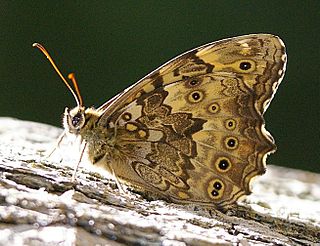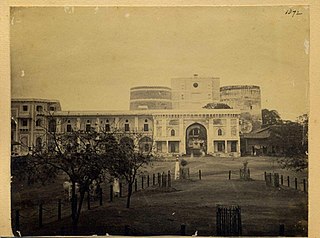Bhadra is a Sanskrit word meaning 'good', 'fortune' or 'auspicious'. It is also the name of many men, women and objects in Hinduism.

Bhadra or Bhadrapada or Bhādo or Bhadraba (Bengali: ভাদ্র bhādro; Hindi: भादों bhādo; Sanskrit: भाद्रपद bhādrapada; Nepali: भाद्र Bhādra; Odia: ଭାଦ୍ରବ Bhadraba; Assamese: ভাদ) is the sixth month of the Hindu calendar, which falls in August and September of the Gregorian calendar. In India's national civil calendar, Bhadra is the sixth month of the year, beginning on middle of August and ending on middle of September. In Hindu astrology, Bhadra begins with the Sun's entry into Leo and is usually the fifth month of the year.

The Tungabhadra River is a river in India that starts and flows through the state of Karnataka during most of its course, Andhra Pradesh and ultimately joining the Krishna River near Murvakonda in Andhra Pradesh

The Bhadra is a river in Karnataka state in southern India.
Bhadra is a city and a municipality in Hanumangarh district in the state of Rajasthan, India.

Bhadra is a 2005 Indian Telugu-language romantic action drama film directed by debutant Boyapati Srinu. Produced by Sri Venkateswara Creations, the film stars Ravi Teja and Meera Jasmine, while Deepak, Prakash Raj, and Pradeep Rawat play supporting roles. The film has music composed by Devi Sri Prasad with cinematography and editing by Arthur A. Wilson and Marthand K. Venkatesh respectively. The film was a Blockbuster at the box-office.

Bhadra Wildlife Sanctuary is a protected area and tiger reserve as part of the Project Tiger, situated in Chikkamagaluru district, 23 km (14 mi) south of Bhadravathi city, 38 km (24 mi) 20 km from Tarikere town, northwest of Chikkamagaluru and 283 km from Bengaluru city in Karnataka state, India. Bhadra sanctuary has a wide range of flora and fauna and is a popular place for day outings. The 1,875 m (6,152 ft) above MSL Hebbe Giri is the highest peak in the sanctuary.

Neope goschkevitschii is a Nymphalidae butterfly found in East Asia. This species looks quite similar to Neope niphonica and these two species were treated as one for a long time.

Mizhi Randilum is a 2003 Malayalam film written and directed by Ranjith, starring Dileep, Kavya Madhavan, Indrajith, Jagathy Sreekumar, Sukumari, and Revathi. The movie was actor Narendra Prasad's last film.

Kannezhuthi Pottum Thottu is a 1999 Indian Malayalam-language drama film, written and directed by T. K. Rajeev Kumar, starring Manju Warrier, Thilakan, Biju Menon, Abbas, and Kalabhavan Mani. The soundtrack was composed by M. G. Radhakrishnan while Sharreth composed the film score; Mohanlal had sung a song Kaithappoovin in the film. Manju Warrier received a National Film Award - Special Mention for her performance. The movie was a super hit at the box office.

Neope yama, the dusky labyrinth, is a species of satyrine butterfly found in Asia. In the Himalayas it is common from the eastern Himalayas to eastern Nepal and less common from western Nepal to Himachal Pradesh.

Neope armandii is a species of satyrine butterfly found in Asia.

Neope pulaha, the veined labyrinth, is a species of satyrine butterfly found in Asia.

Bhadra Fort is situated in the walled city area of Ahmedabad, India. It was built by Ahmad Shah I in 1411. With its well carved royal palaces, mosques, gates and open spaces, it was renovated in 2014 by the Amdavad Municipal Corporation (AMC) and the Archaeological Survey of India (ASI) as a cultural centre for the city.

Bhadra is one of the Ashtabharya, the eight principal queen-consorts of Hindu god Krishna, according to the scripture Bhagavata Purana. The Bhagavata Purana regards her as being the eighth wife of Krishna; sometimes she is described as the seventh wife. The Vishnu Purana and the Harivamsa do not name Bhadra at all in the list of the Ashtabharya, but refer to her as 'the daughter of Dhrishtaketu' or 'the princess of Kekeya'.
Bhadra (भद्र) is a Sanskrit word and also the name of many Hindu mythological characters.

Neope is a genus of butterflies of the family Nymphalidae found in Asia.

Neope muirheadii, the black-spotted labyrinth, is a species of butterfly in the family Nymphalidae. It is found in western and central China, Southeast Asia, and Taiwan.
The Odia calendar is a solar calendar used by the Odia people from the Odisha region of the Indian subcontinent. The calendar follows the sidereal solar cycle while using the lunar Purnimanta phase for the religious dates. The New Year in the Odia calendar is known as Maha Bishuba Sankranti or Pana Sankranti. It occurs on the first day of the traditional solar month of Meṣa, hence equivalent lunar month Baisakha. The Odia calendar follows the Utkaliya era, which began on Bhādra śukla dvādaśī from 592 CE.














